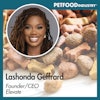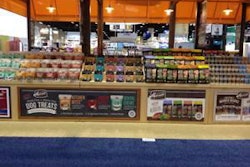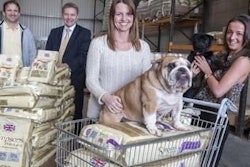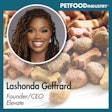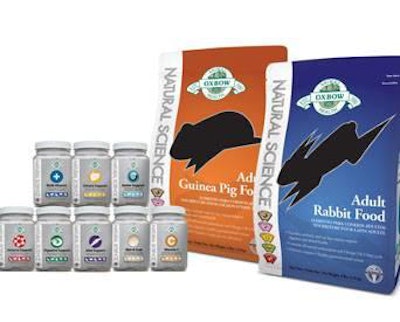
In 2013, US pet owners boasted 116 million fish, birds, small animals and reptiles, according to the 2013 Packaged Facts report, Pet Populations and Pet Owner Trends in the US: Fish, Birds, Reptiles and Small Animals. Fish tanks could be found in 7.2 million homes and bird cages in 4.6 million households. Reptiles lived in 1.8 million US homes, and 2.5 million adults had pet rabbits. Given those numbers, it's clear that the small pet segment has a solid role to play in the overall petfood industry.
While growth in the "other" petfood category has been slow in response to the US economic recession, sales are expected to increase through 2017. In 2013, roughly $898 million came from sales of petfood for birds, small animals, fish, and reptiles and amphibians-just 2% growth from 2012 numbers, according to Packaged Facts' report, Pet Food in the US 10th Edition. However, growth is expected at 2.5% in 2014 and 3% the next few years, with sales topping $1 billion in 2017.
In 2012, 43% of the category's petfood sold was for birds, 32% was for fish, 16% was for small animals such as rabbits and guinea pigs and 9% was for reptiles, according to Packaged Facts. Further, according to the American Pet Product Association, the most popular pets found in households are freshwater fish (41.7% of pet-owning households), beating out both cats (22.7% of pet-owning households) and dogs (18.9%). Small animals can be found in 3.9% of households, birds come in at 3.6% and reptiles have homes in 3.3% of pet-owning households.
Unsurprisingly, the top trend in the pet industry-the humanization of pets-is going strong in the small animal segment, and companies are responding to it. "Today's small animals are more than just pets; they're valued members of the family," says Melissa Ross, director of marketing and education at Oxbow Animal Health. "As the popularity of small animals as pets has grown, so too have the expectations of their owners. Today's small animal pet parents are dedicated label readers and want to know exactly what goes into the food or treats they're offering to their animals. They desire wholesome, healthy ingredients in an honest presentation. This kind of passion not only benefits the overall health of pets, but it holds the industry accountable to use healthy, high-quality ingredients and to present them using an appropriate level of transparency."
Organic and all-natural food and treats for small animals are becoming hot items as a result of consumers' desires to have their pets' diets mirror their own. Oxbow offers its organic BeneTerra line of products, which include guinea pig food, rabbit food, barley biscuits and meadow hay. Vitakraft Sunseed has a natural SunSations Diets line, with each diet made up of fruits and vegetables blended with grains, seeds, specialty ingredients, herbal ingredients and pellets. The company also offers all-natural, no-sugar-added drops treats for rabbits, guinea pigs, hamsters and chinchillas. Marshall Pet has a line of all-natural fruit and vegetable treats, Peter's Nature Treats, made with rabbits, chinchillas, gerbils, hamsters, guinea pigs and other small animals in mind.
The desire to ensure their pets are healthy has led owners of small pets to the petfood aisles, as well. "Today's pet parents are more proactive than ever," says Ross. "Rather than sitting idly by and allowing their pets' health to deteriorate over time, these pet parents actively search for nutritional support and solutions for their pets' nutritional and health needs." Some companies have responded to this need with novel ingredients.
Oxbow, for example, offers a Natural Science line that includes rabbit and guinea pig foods with ingredients such as canola, tomato, rosemary and thyme. The company also has supplements, made with high-fiber Western Timothy hay and herbal ingredients, formulated to support specific health and wellness needs in small pets. Three new supplements include Senior Support, Skin & Coat and Vitamin C. Vitakraft offers SunSations treats and toys that promote interaction and provide mental enrichment, according to the company, including Yumbo Pops treats and the Brain Teaser puzzle toy that has treats hidden inside. Scarlett Petfood has a Mardi Gras line of nutritious complete petfood solutions for small animals, as well as a fruit and nut mix for birds made with all human-grade fruit including papaya chunks, split peanuts, raisins, sunflower kernels, pumpkin seeds, diced apples and dried cherries.
In general, premium petfood offerings are a continued growing trend. According to Packaged Facts, key new product thrusts in the small pet segment include fortified/functional products, those positioned along gourmet lines, products offering greater convenience and ease of use, and claims including natural, "green" and recyclable. Products targeted to specific pet types and health conditions are also important to the market right now.
In the small animal market, consumer desire for convenience and cost savings has led to more functional and fortified petfood products. Species-specific formulas continue to be a trend, focusing on digestibility of ingredients, ideal pellet size and added-nutrient composition.
The convenience and potential monetary savings of combining all a bird's nutritional needs into a single food is also growing more popular in the bird market. This has led to more products that claim to take the place of dietary supplements, so-called "complete nutrition" bird food with added nutrients. Bird treats reflect the humanization trend, with more products mimicking human food or being human-grade.
Functional foods are also gaining ground with the fish market, according to Packaged Facts, with additives that claim to improve digestion (such as probiotics) and overall health (immunostimulants, omega-3). Frozen and live foods, such as bloodworms and brine shrimp, are also growing in popularity, though flake food remains a stable.
The reptile and amphibian segment, much like the others, has begun to focus on species-specific foods and nutritional supplements. Complete diets include the daily required vitamins and minerals for a specific animal, so no supplements are necessary. Supplements, when used, help make up for the difficulties of providing a domestic diet that adequately mimics what reptiles and amphibians would have access to in nature.
"We absolutely feel that these trends will continue through 2014 and beyond," says Ross. "The human/animal bond is stronger than ever and will only continue to grow. As it does, a strong segment of the market will continue to seek out premium options for their pets, as well as solutions to the health and wellness needs of their pets. Pet parents will continue to seek quality with products and ingredients, and honesty in the ways products are marketed. As far as new trends go, we anticipate more customers seeking both innovation and convenience in their pet parenting experience."


